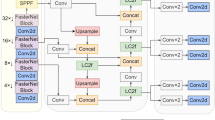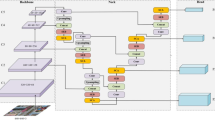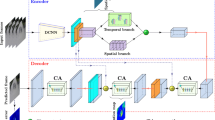Abstract
Fish escapes due to breaches in deep-sea netting can affect local ecosystems. To accurately and quickly detect broken netting, we propose YOLOv7-net, an efficient deep-sea netting breakage detection method based on attention and focusing on the receptive-field spatial feature. First, Bi-level Routing Attention (BRA) is introduced to enhance the acquisition of feature information at different scales. Second, a new coordinated attention module (RFCAConv) that focuses on the spatial features of the receptive field is used to capture more detailed feature information. Finally, a new network module called CFE that integrates efficient channel attention (ECA) and FasterNet during cross-stage connections is designed, enhancing the ability of the network to express features while reducing the number of required parameters and computational complexity. The results obtained on a self-constructed broken netting dataset show that the precision, recall, AP, F1 score and detection speed of YOLOv7-net are 2.8%, 1.8%, 2.4%, 2%, and 8.92 fps higher than those of YOLOv7, respectively, and the proposed approach can be specifically used to identify deep-sea netting damage. Our method improves the efficiency of broken netting detection in complex marine environments, providing new insights into the development of mariculture equipment and the protection of ecosystems.







Similar content being viewed by others
Data availability
The broken netting datasets generated during the current study are available from the corresponding author upon reasonable request.
References
Sangirova, U., Khafizova, Z., Yunusov, I., Rakhmankulova, B., Kholiyorov, U.: The benefits of development cage fish farming. In: E3S Web of Conferences. EDP Sciences, Vol. 217, p. 09006 (2020). https://doi.org/10.1051/e3sconf/202021709006
Zhao, Y., Zhang, J., Liu, Y., Sun, K., Zhang, C., Wu, W., Teng, F.: Numerical assessment of the environmental impacts of deep sea cage culture in the Yellow Sea, China. Sci. Total. Environ. 706, 135752 (2020). https://doi.org/10.1016/j.scitotenv.2019.135752
Yang, X., Holmen, I.M., Utne, I.B.: Scenario analysis of fish escapes in Norwegian aquaculture for implementation of barrier management and improved learning from accidents. Mar. Policy 143, 105208 (2022). https://doi.org/10.1016/j.marpol.2022.105208
Brown, C., Miltiadou, D., Tsigenopoulos, C.S.: Prevalence and survival of escaped European seabass Dicentrarchus labrax in Cyprus identified using genetic markers. Aquac. Environ. Interact. 7(1), 49–59 (2015). https://doi.org/10.3354/aei00135
Jackson, D., Drumm, A., McEvoy, S., Jensen, Ø., Mendiola, D., Gabiña, G., Borg, J.A., Papageorgiou, N., Black, K.D.: A pan-European valuation of the extent, causes and cost of escape events from sea cage fish farming. Aquaculture 436, 21–26 (2015). https://doi.org/10.1016/j.aquaculture.2014.10.040
Atalah, J., Sanchez-Jerez, P.: Global assessment of ecological risks associated with farmed fish escapes. Global Ecol Conserv 21, e00842 (2020). https://doi.org/10.1016/j.gecco.2019.e00842
Herrmann, B., Sistiaga, M., Jørgensen, T.: Size-dependent escape risk of lumpfish (Cyclopterus lumpus) from salmonid farm nets. Mar. Pollut. Bull. 162, 111904 (2021). https://doi.org/10.1016/j.marpolbul.2020.111904
Arechavala-Lopez, P., Milošević-González, M., Sanchez-Jerez, P.: Using trace elements in otoliths to discriminate between wild and farmed European sea bass (Dicentrarchus labrax L.) and Gilthead sea bream (Sparus aurata L.). Int. Aquatic Res. 8, 263–273 (2016). https://doi.org/10.1007/s40071-016-0142-1
Betancourt, J., Coral, W., Colorado, J.: An integrated ROV solution for underwater net-cage inspection in fish farms using computer vision. SN Appl. Sci. 2, 1–15 (2020). https://doi.org/10.1007/s42452-020-03623-z
Zhao, Y.P., Niu, L.J., Du, H., Bi, C.W.: An adaptive method of damage detection for fishing nets based on image processing technology. Aquacult. Eng. 90, 102071 (2020). https://doi.org/10.1016/j.aquaeng.2020.102071
Paspalakis, S., Moirogiorgou, K., Papandroulakis, N., Giakos, G., Zervakis, M.: Automated fish cage net inspection using image processing techniques. IET Image Proc. 14(10), 2028–2034 (2020). https://doi.org/10.1049/iet-ipr.2019.1667
Liao, W., Zhang, S., Wu, Y., An, D., Wei, Y.: Research on intelligent damage detection of far-sea cage based on machine vision and deep learning. Aquacult. Eng. 96, 102219 (2022). https://doi.org/10.1016/j.aquaeng.2021.102219
Zhang, Z., Gui, F., Qu, X., Feng, D.: Netting damage detection for marine aquaculture facilities based on improved mask r-CNN. J. Mar. Sci. Eng 10(7), 996 (2022). https://doi.org/10.3390/jmse10070996
Wang, C. Y., Bochkovskiy, A., Liao, H. Y. M.: YOLOv7: trainable bag-of-freebies sets new state-of-the-art for real-time object detectors. http://arxiv.org/abs/2207.02696. https://doi.org/10.48550/arXiv.2207.02696 (2022)
Redmon, J., Divvala, S., Girshick, R., Farhadi, A.: You only look once: unified, real-time object detection. CVPR, pp. 779–788. https://doi.org/10.1109/CVPR.2016.91 (2016)
Redmon J., Farhadi, A.: YOLO9000: better, faster, stronger. In: ICVPR, pp. 7263–7271. https://doi.org/10.1109/CVPR.2017.690 (2017)
Redmon, J., Farhadi, A.: Yolov3: an incremental improvement. http://arxiv.org/abs/1804.02767. https://doi.org/10.48550/arXiv.1804.02767 (2018)
Bochkovskiy, A., Wang, C. Y., Liao, H. Y. M.: Yolov4: optimal speed and accuracy of object detection. http://arxiv.org/abs/2004.10934. https://doi.org/10.48550/arXiv.2004.10934 (2020)
Ge, Z., Liu, S., Wang, F., Li, Z., Sun, J.: Yolox: exceeding yolo series in 2021. http://arxiv.org/abs/2107.08430. https://doi.org/10.48550/arXiv.2107.08430 (2021)
Li, C., Li, L., Jiang, H., Weng, K., Geng, Y., Li, L., Ke, Z., Li, Q., Cheng, M., Nie, W., Li, Y., Zhang, B., Liang, Y., Zhou, L., Xu, X., Chu, X., Wei, X.: YOLOv6: a single-stage object detection framework for industrial applications. http://arxiv.org/abs/2209.02976. https://doi.org/10.48550/arXiv.2209.02976 (2022)
Hou, Q., Zhou, D., Feng, J.: Coordinate attention for efficient mobile network design. In: Proceedings of the IEEE/CVF Conference on Computer Vision and Pattern Recognition (CVPR), pp. 13713–13722. https://doi.org/10.48550/arXiv.2103.02907 (2021)
Chen, J., Kao, S. H., He, H., Zhuo, W., Wen, S., Lee, C. H., Chan, S. H. G.: Run, Don't Walk: chasing higher FLOPS for faster neural networks. In: Proceedings of the IEEE/CVF Conference on Computer Vision and Pattern Recognition, pp. 12021–12031. https://doi.org/10.48550/arXiv.2303.03667 (2023)
Acknowledgements
This research was supported by the Guangdong Provincial Special Project for Marine Economic Development (Six Major Marine Industries) (GDNRC [2021] 42) and the Zhanjiang Key Laboratory of Modern Marine Fishery Equipment (2021A05023).
Author information
Authors and Affiliations
Contributions
GYY provided project support. JPS proposed an idea for the improvement algorithm and wrote the main manuscript text. YTL verified the results and reviewed the manuscript. ZJC, QBC, and SXC Collected a dataset of broken netting.
Corresponding author
Ethics declarations
Conflict of interest
The authors declare that there are no conflicts of interest related to this article.
Additional information
Publisher's Note
Springer Nature remains neutral with regard to jurisdictional claims in published maps and institutional affiliations.
Rights and permissions
Springer Nature or its licensor (e.g. a society or other partner) holds exclusive rights to this article under a publishing agreement with the author(s) or other rightsholder(s); author self-archiving of the accepted manuscript version of this article is solely governed by the terms of such publishing agreement and applicable law.
About this article
Cite this article
Yu, G., Su, J., Luo, Y. et al. Efficient detection method of deep-sea netting breakage based on attention and focusing on receptive-field spatial feature. SIViP 18, 1205–1214 (2024). https://doi.org/10.1007/s11760-023-02806-6
Received:
Revised:
Accepted:
Published:
Issue Date:
DOI: https://doi.org/10.1007/s11760-023-02806-6




